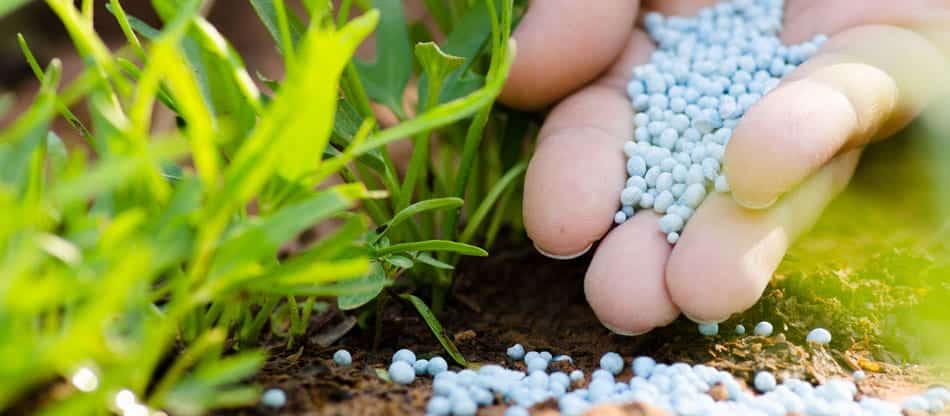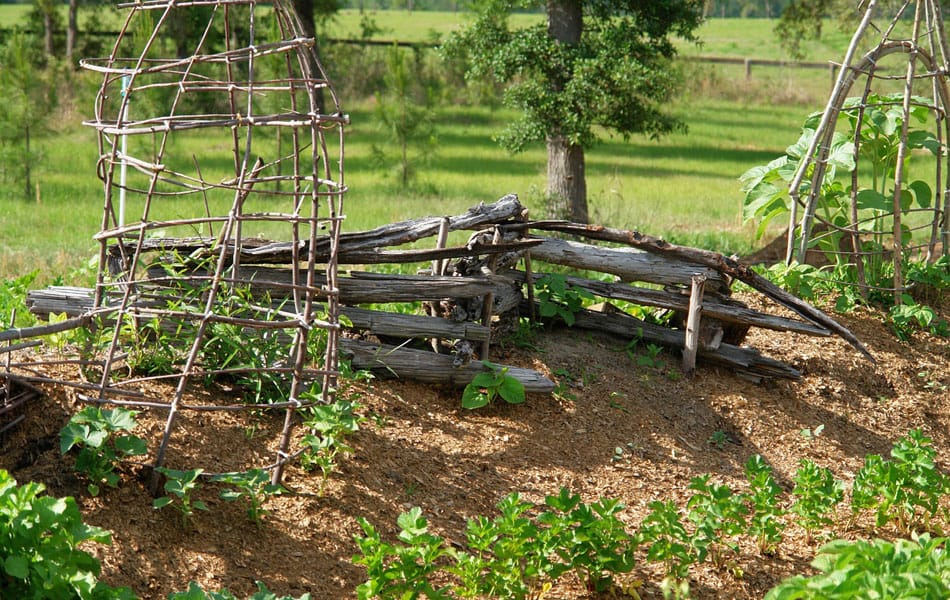When your yard looks good, with trees full of leaves and shrubs, an emerald lawn, and perennials covered in blooms, you may think your garden can carry on without you. In fact, your yard needs you to guide its growth and keep it vigorous and resilient! And the basis for a healthy garden is healthy soil.
Invest in Your Soil Now & Reap the Rewards Later
While your plants make leaf and flower growth look easy, the reality is that they’re burning through their energy reserves. After a summer of growth and flowering, they need to replenish those reserves. Unfortunately, our (sub)urban soil often doesn’t contain enough nutrients to meet these needs – so we add fertilizer.
Frequently, our urban and suburban soils are depleted of nutrients from poor maintenance practices that remove organic matter or because native topsoil has been disturbed or buried. Unlike forest soils, your garden soil hasn’t been enriched with nutrients from eons of undisturbed organic matter. As a result, it needs your regular help to keep its health at an optimum level.
Think of fertilizing and amending your soil as making deposits into a savings account, only it’s your plants’ roots that will make annual withdrawals.
When you maintain healthy soil and keep it fertile with balanced nutrients (and topped with mulch!) you’ll help keep your trees and shrubs growing vigorously, without stressing them and making them susceptible to pests and diseases.
Nutrient Shortages = Unhealthy Plants
While many plant species will soldier on without all the nutrients they need, you’ll see the results in their reduced growth and poor overall appearance.
Signs of stress from nutrient shortages in your soil may include:
- Yellow or undersized leaves
- Leaf and twig die-back
- Overall slow growth
- Fewer, smaller flowers and fruit
- Patchy, yellow lawns
These signs mean your plants, trees, and turf are trying to fulfill their regular growth patterns but don’t have enough energy and nutrients to complete them.
NOTE: Some symptoms of stress may be the result of other things, such as over- or under watering, soil compaction, or disease. Check your irrigation system if plants look stressed in summer. If you’re not sure of the cause, call us for a consultation before the problem gets too bad.
 Investigate Before Doing DIY Fertilization
Investigate Before Doing DIY Fertilization
Many people choose to do their own fertilizing – just be sure you fully understand the type, quantity, and application schedule that will provide the best results. Without that, you risk leaf burn, unnecessary expense and waste, and you may even break the law!
Yes, there’s a law against over-fertilizing. In New Jersey, runoff from fertilizer is taken seriously because of the serious effects it has on our waterways and the flora and fauna in them. Learn how New Jersey’s fertilizer law affects you so you can avoid causing harm or getting a fine.
Nitrogen and phosphorus are two of the most-used fertilizer macronutrients and are frequently overused. Over-application of these nutrients means runoff water carries excess nitrogen and phosphorus to our streams and rivers. There, they cause algae blooms, reduce oxygen in water, kill fish and wildlife, and seep into our underground aquifers.
If you want to apply fertilizer yourself, always follow directions on fertilizer packaging, especially the warnings about over-application of nitrogen and phosphorus.
But if you want to be sure your plants are getting the right nutrients and soil amendments, hire a professional. And remember, if you hire someone to fertilize your property, they need a certification to apply fertilizer correctly, and can only do it during certain times of year.
Test Before You Start
To ensure your plants are getting exactly what they need, perform a soil test before applying fertilizer. Without an analysis of your soil’s mineral and nutrient levels, fertilizing is an uninformed guess.
For example, let’s say your plants are developing yellowing leaves. Without a soil test, you may be tempted to add nitrogen to green up the leaves. But if the soil is lacking iron (a common cause of chlorosis, or yellow leaves), all the nitrogen fertilizer you apply won’t fix the problem. And if you add more phosphorus to your soil, your plants will struggle even more to absorb any iron at all.
Soil testing (and then basing fertilization on the results) ensures you’ll add just the nutrients and amendments your plants need – nothing more, nothing less. This means you’ll have steady levels of nutrition year-round and your plant and tree roots can take up those nutrients as they need them.
The Best Way to Fertilize
For maximum results, we use deep-root fertilization. Using injection tools, we apply fertilizer directly to the rhizosphere of your plants (the area under the soil surface where plant feeder roots and beneficial soil organisms intermingle). Injecting fertilizers in a plant’s rhizosphere ensures that our nutrient mix and soil conditioning components are added where they’re most useful and our injection technique aerates compacted soil at the same time.
This technique is the most effective and efficient method for soil enhancement and enrichment. There’s no runoff, no wasted material, and everything is exactly where the plants need it.
The Best (& Legal) Times of Year to Fertilize
Spring and fall are the best (and legal) times to improve your soil’s nutrient levels. Spring fertilization ensures your plants and trees will grow vigorously when they awake from dormancy and prepare for summer’s long growth period. Fall fertilization provides a boost of nutrients and help plants add to their energy stores to prepare for dormancy and the long winter ahead.
The Best Type of Fertilizer
You’re likely very familiar with the granular fertilizers that are spread on lawns or sprinkled in garden beds. These are largely composed of fast-acting, synthetic chemicals and are intended to deliver a quick jolt of energy to your plants, resulting in rapid growth. While there’s a time and place for these types of fertilizer (in limited amounts!), there’s a much better alternative.
We use, and strongly recommend, organic materials that not only provide readily accessible plant nutrients, they also build healthy soil. And healthy soil means healthy plants.
When looking for organic soil “food,” look for a slow-release blend of:
- minerals,
- sea kelp,
- fish hydrosolate (nutrients enzymatically extracted from fish waste),
- beneficial root fungi (mycorrhizae),
- humates (extractions from humus, the organic matter that provides long-term soil improvement)
This type of combination, especially when injected into the root zone, provides a far superior and long-lasting boost to plant health.
 Other Ways to Improve Soil Health
Other Ways to Improve Soil Health
In addition to targeted fertilizer injections, you can improve your soil in the long term by doing the following:
- Add Compost. Adding compost to your soil improves its structure, water-holding capacity, and long-term fertility, and helps undisturbed soil increase its carbon-sequestering ability. Our soil treatments include “compost tea” (a terrific soil conditioner) that provides many of the benefits of compost in an easy-to-apply liquid form.
- Add Mulch. Always mulch your garden beds and around your trees. A three-inch layer of organic mulch regulates soil temperature, reduces water evaporation from soil, and keeps weed growth down. Just be sure to pull it a few inches away from tree trunks and plant stems to prevent fungal damage. And never do this to your plants!
If you have room in your garden, you can make leaf compost and leaf mulch from your own trees’ fall leaves instead of having them hauled away.
We’re Here to Help
Ensuring all types of plants on your property are adequately fertilized can be a big job. Fortunately, help is at hand. In addition to our tree, shrub, and lawn services, we offer fertilization services that are tailored to your garden’s needs and applied at the correct times of year: spring and fall.
Our organic soil health blend, plus deep-root fertilization for trees and shrubs, makes our method superior to the surface application of fast-acting, synthetic fertilizers that you might buy in a nursery center or hardware store.
LEARN ABOUT OUR FERTILIZATION SERVICES
From early pruning of young trees to ensure they develop a healthy, life-long branch structure to using beneficial insects for pest control to our pledge to use organic methods and ingredients, we take a big-picture, long-term view of your plants, trees, and soil so that they stay healthy and resilient for a long time to come.
GET THE LATEST NEWS
Subscribe to the Organic Plant Care Newsletter and get timely and helpful tips and updates monthly.
There's no spam - we promise!





